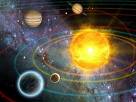Homeworks 9
| ||||||||
Homework 9 is the attempted solution to our 9th assignment in the course Introduction to Astrophysics. This assignment was assigned on the week of November 1st and the due date was initially 11/16/2009 due to a typo it was moved up a week to Monday 11/09/2009. Professor Hoeflich will still accept the homework next day Tuesday 11/10/2009 at his office hours (1:25 PM 614 Keen).
Solutions were created by Group 1 (RyanT, KimW, SaraC, ZackM, and TiaraD) to be completed by Friday 11/13/09.
This assignment covers Chapters 19 through 22 in the book, Lectures 27 through 30. The topics in this assignment deal with the makeup of our solar system: the sun, planets & their moons, asteroids & the belt, comets, meteroids, dust and gas.
Problem 1
What are the compositions of meteorites? How do we know that most meteorites used to be part of larger bodies?
When asteroids collide with one another, they can produce small fragments known as meteoroids. If a meteoroid should happen to enter Earth’s atmosphere, the heat generated by friction results in a glowing streak across the sky, referred to as a meteor. If the rock survives the trip through the atmosphere and strikes the surface, the remnant is known as a meteorite. By analyzing the composition of meteorites, we can learn a great deal about the environment in which they originated.
Meteorites have traditionally been divided into three broad categories:
- Stony meteorites are rocks mainly composed of silicate minerals. Some of them contain small amounts of organic matter, including amino acids, and presolar grains. These are considered to be the building blocks of planets.
- Iron meteorites are largely composed of metallic iron-nickel. Some of them have intergrowths of iron-nickel alloys, such as kamacite and taenite. Most iron meteorites are thought to come from the core of a number of asteroids that were once molten.
- Stony-iron meteorites contain large amounts of both metallic and rocky material. They are a mixture of iron-nickel metal and silicate minerals
Problem 2
Name all the different kinds of objects found in the solar system. Give three distinguishing characteristics of each.
The Sun: The center of the Solar System; approximately 99.86% of the total mass of the Solar System; typical main sequence star.
Terrestrial (inner) planets: relatively low mass; rocky surfaces; slow rotational speed.
Jovian (outer) planets: relatively large mass; mostly gaseous/liquid with a small rocky core; rapid rotational speed.
Asteroid Belt: occupies the orbit between Mars and Jupiter; comprised of remnants from the Solar System's formation; comprise about 9x10^-8 percent of the Solar System's mass; comprised mainly of rock and metal.
Kuiper Belt: occupies the orbit beyond Neptune; 20 to 200 times as massive as the Asteroid Belt; comprised mainly of ices; home to Pluto and Charon.
Comets: larger than a meteoroid; comprised mosly of ice, dust, and frozen gases; prominent glowing "tail" is evaporated gases flowing from comet.
Meteoroids: anywhere from the size of a sand grain to a boulder; comprised mainly of rock/metal or ice; meteoroids that reach the Earth's surface are called "metoerites".
Problem 3
Make a table comparing the atmospheres of the Earth, Venus, and Mars. List the two most important gasses, the typical temperatures, and typical pressures in terms of the Earth’s atmospheric pressure. Describe briefly the formation of the atmosphere of each of them (use the atmospheric escape parameters for various components).
Problem 4
Name Jupiter’s four Galilean moons in order from the closest to the most distant from Jupiter. Give a distinctive characteristic of each moon. Why does the closest moon have such strong tectonic activity? Estimate the tidal force on each of them.
Io, Europa, Ganymede, Callisto
Io- most geologically active Europa- layer of water surrounding mantle Ganymede- has magnetic field Callisto- has thin atmosphere of CO_2 and O_2
Io's tectonic activity is due to heating from friction inside of the moon due to Jupiter's pull.
Io:
r=4.22*10^9 m
m=8.93*10^22 kg
Europa:
r=6.71*10^8 m
m=4.8*10^22 kg
Ganymede:
r=1.07*10^9 m
m=1.48*10^23 kg
Callisto:
r=1.88*10^9 m
m=1.075*10^23 kg
Jupiter:
r=7.50*10^11 m
m=1.90*10^27 kg
Sun:
m=1.99*10^30 kg
Io:6.07*10^20 N
Europa:1.32*10^22 N
Ganymede: 1.63*10^22 N
Callisto:3.83*10^21 N
Problem 5
Assume that the initial atmosphere of Mars would consist of H/He. Calculate the escape parameter for a H/He atmosphere for Mars. Estimate the particle density in a primordial upper atmosphere assuming a temperature of 1000K. Assume that the particle density of H/He is the same as todays Mars atmosphere. How long would it take for a H/He atmosphere to evaporate?

